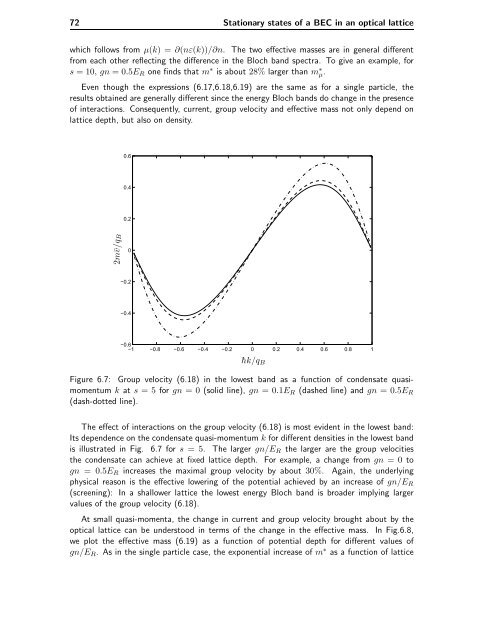Bose-Einstein Condensates in Rotating Traps and Optical ... - BEC
Bose-Einstein Condensates in Rotating Traps and Optical ... - BEC
Bose-Einstein Condensates in Rotating Traps and Optical ... - BEC
Create successful ePaper yourself
Turn your PDF publications into a flip-book with our unique Google optimized e-Paper software.
72 Stationary states of a <strong>BEC</strong> <strong>in</strong> an optical lattice<br />
which follows from µ(k) =∂(nε(k))/∂n. The two effective masses are <strong>in</strong> general different<br />
from each other reflect<strong>in</strong>g the difference <strong>in</strong> the Bloch b<strong>and</strong> spectra. To give an example, for<br />
s =10,gn=0.5ER one f<strong>in</strong>ds that m ∗ is about 28% larger than m ∗ µ.<br />
Even though the expressions (6.17,6.18,6.19) are the same as for a s<strong>in</strong>gle particle, the<br />
results obta<strong>in</strong>ed are generally different s<strong>in</strong>ce the energy Bloch b<strong>and</strong>s do change <strong>in</strong> the presence<br />
of <strong>in</strong>teractions. Consequently, current, group velocity <strong>and</strong> effective mass not only depend on<br />
lattice depth, but also on density.<br />
2m¯v/qB<br />
0.6<br />
0.4<br />
0.2<br />
0<br />
−0.2<br />
−0.4<br />
−0.6<br />
−1 −0.8 −0.6 −0.4 −0.2 0 0.2 0.4 0.6 0.8 1<br />
¯hk/qB<br />
Figure 6.7: Group velocity (6.18) <strong>in</strong> the lowest b<strong>and</strong> as a function of condensate quasimomentum<br />
k at s =5for gn =0(solid l<strong>in</strong>e), gn =0.1ER (dashed l<strong>in</strong>e) <strong>and</strong> gn =0.5ER<br />
(dash-dotted l<strong>in</strong>e).<br />
The effect of <strong>in</strong>teractions on the group velocity (6.18) is most evident <strong>in</strong> the lowest b<strong>and</strong>:<br />
Its dependence on the condensate quasi-momentum k for different densities <strong>in</strong> the lowest b<strong>and</strong><br />
is illustrated <strong>in</strong> Fig. 6.7 for s =5. The larger gn/ER the larger are the group velocities<br />
the condensate can achieve at fixed lattice depth. For example, a change from gn =0to<br />
gn = 0.5ER <strong>in</strong>creases the maximal group velocity by about 30%. Aga<strong>in</strong>, the underly<strong>in</strong>g<br />
physical reason is the effective lower<strong>in</strong>g of the potential achieved by an <strong>in</strong>crease of gn/ER<br />
(screen<strong>in</strong>g): In a shallower lattice the lowest energy Bloch b<strong>and</strong> is broader imply<strong>in</strong>g larger<br />
values of the group velocity (6.18).<br />
At small quasi-momenta, the change <strong>in</strong> current <strong>and</strong> group velocity brought about by the<br />
optical lattice can be understood <strong>in</strong> terms of the change <strong>in</strong> the effective mass. In Fig.6.8,<br />
we plot the effective mass (6.19) as a function of potential depth for different values of<br />
gn/ER. As <strong>in</strong> the s<strong>in</strong>gle particle case, the exponential <strong>in</strong>crease of m ∗ as a function of lattice




